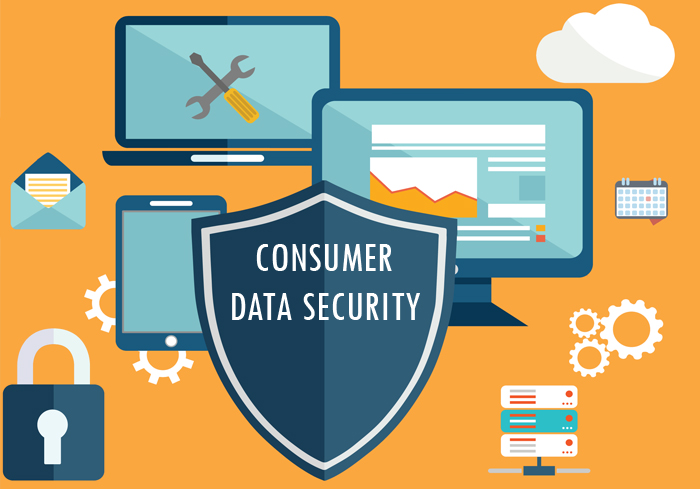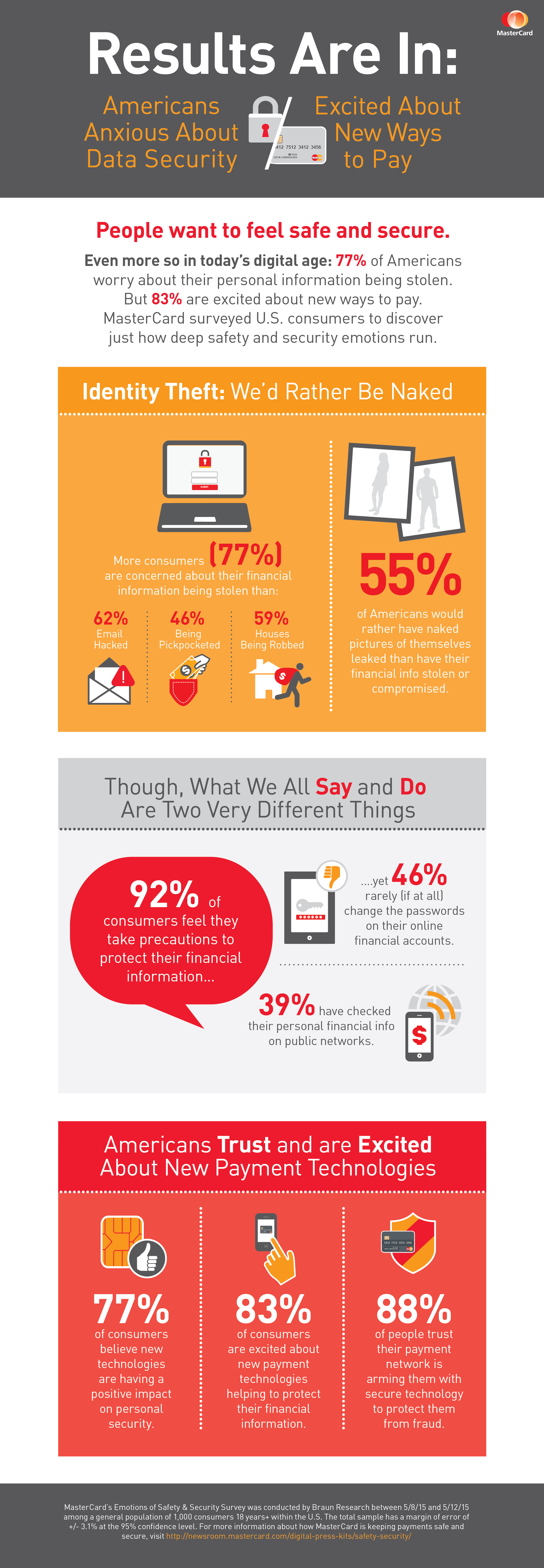MasterCard’s Report On Consumers And Data Security

What worries consumers more – having their house robbed or having their financial information compromised? The answer to that, along with fresh new insights about how consumers feel about money and the security of their payments and financial assets was the topic of conversation between MPD CEO Karen Webster and MasterCard’s Group Head of Product Delivery, Carolyn Balfany. MasterCard’s brand new research – released today – on the topic and their findings are both new and newsmaking.
KW: What surprised you the most about the work that you did? What did you find consumers were concerned about that perhaps you didn’t know before?
CB: Well, first, we recognize that consumers have been impacted by recent events – one in three surveyed said they had their financial information compromised within the past two years. What’s more, they’re fairly pessimistic looking forward over the next two to three years, expecting that number to only increase. Roughly three-fourths of consumers — 77 percent — expressed concerns about their financial information. The surprising factor is not how high that number is, but that it actually outpaces the concern consumers have about other events. For instance, only 62 percent of those surveyed said they would be concerned about their email being hacked, while 59 percent expressed concern about their house being robbed and just 46 percent said they were concerned about being pickpocketed. This contrast is surprising and certainly a sign of the times.
KW: Do consumers distinguish between financial information, such as bank account details, and payment card information, like credit and debit card numbers? Did you get a sense from the survey as to whether or not consumers think of them as the same thing or think of them separately, with different fears and concerns based on the characteristics of the information that might be at risk?
CB: Our survey did not ask consumers explicitly to dissect or identify them differently, although we know from other studies they generally tend to feel similarly about the information. When it comes to card data, consumers are quick to explain that they understand they are not liable for fraudulent activities, which is terrific from MasterCard’s perspective and is a primary benefit of using electronic payments. Of course, that does not minimize the disruption and concerns caused by the experience of fraudulent activities – even if consumers do believe they are not responsible for the resulting fraud, it causes some kind of disruption to the ability to make payments while waiting to receive a new card and have an account updated. Consumers still express concern about those transactions in the meantime.
KW: Have you seen these concerns change over time?
CB: Yes, it has continued to elevate over the past couple of years. But not surprising again, given the level of fraudulent activity that we have seen.
KW: In the survey results consumers mention feeling as though they do enough to protect their financial information, but when probed and asked specifically about what they did, MasterCard discovered perhaps they are not doing as much as they believe they are doing. As an industry, what is it we need to do to get consumers more motivated to take actions like changing their passwords or not using the same password across multiple sites?
CB: You’re right about some of the contradictions we saw. Approximately half of the consumers surveyed believed they were personally responsible for protecting their own information and roughly 92 percent said they felt as though they take precautions to protect themselves from information being lost or compromised. About 86 percent of respondents also expressed they would invest more time or energy into adopting new technologies if it promised greater security for them.
But there are several things consumers confessed to doing, such as not changing passwords, using the same password across multiple accounts and using public networks to check sensitive information.
As far as what we can do as an industry, the answer lies in heightened awareness and communicating even more rigorously the benefits of the technologies introduced and ways consumers can help protect themselves. Especially because consumers are telling us they are ready to embrace these technologies.
KW: Is the enthusiasm consumers are showing for new technologies, like chip cards or mobile payments, and their comfort factor in terms of safety, soundness and security of their information consistent along both online and physical channels? Is their comfort level dependent upon where they are using those devices or what they are using to transact?
CB: We did not discern any differences in the way consumers pay, whether that is in a physical channel or online, or even how they pay, whether it was with a card or mobile device and how they authenticate themselves in that transaction. What consumers seem to be telling us is they want to be empowered with new ways to pay and are willing to adopt the technologies introduced to them to make that possible.
Specifically, consumers reported being very open to using chip cards, almost 30 percent of U.S. shoppers now have chip cards in their wallets and are preparing to use them. In general, respondents expressed a willingness to use mobile digital payments, and are either using mobile payment methods now or plan to do so soon. When asked questions about biometrics, which sometimes garners a more passionate response, roughly three-fourths of consumers surveyed said they were familiar with biometrics and many showed an interest in using the technology as an identification method. This one in particular goes back to taking away some of the burden on consumers to remember an increasing number of passwords, we don’t have to remember what our fingerprint is in order to use it.
KW: What does this tell you about the relationship consumers have with their money? Are there any insights there?
CB: One of the fun parts of the survey was asking consumers how they see money. Those of us in the financial industry tend to see money in very precise ways, so it was interesting to hear from 66 percent of consumers that they saw money as a means of providing daily needs such as food, rent and clothes. Another half of the respondents said they see money as a means to support their families, explaining that they live for family dinners, weekends coaching soccer or baseball, and vacations with the car loaded down with bikes and boogie boards. While others said they see money as freedom and also as a means to freedom. It interested MasterCard to look deeper at these emotions by exploring what money means to a consumer’s daily life and what that can tell us about how to introduce new technologies.
A consumer who sees money as a means of providing for daily needs tells us that from a technology standpoint, there needs to be a focus on creating easy, hassle-free, safe and ubiquitous payments methods, which can be seamlessly moved into a consumer’s daily life. But if a consumer sees money as a way to support family, that same consumer will probably need money to equate more tightly to security and peace of mind, which takes us back to introducing services such as zero liability and identify theft alerts. For those who associate money with freedom and value independence, it provides us with insight into how to leverage technology to make it possible. This can be through enabling mobile devices, which allows freedom seekers to just go and do, whether they are paying with their phone in their hand or something on their wrist.
This information tells us something about the human experience and the interception of technology. It was fun to look at this through a new lens.
KW: It sounds like regardless of what the trigger point is for the emotion of money, consumers expect it to be available to them in a way they can easily access, feel secure about and trust. This seems to be a common denominator across all three of the ways consumers view money, whether it’s seen as a daily requirement, the freedom to do whatever you want to do or a means to enrich family experience.
CB: Conventional wisdom would have told us to expect to see some of the metrics break across generational lies. For example, it is intuitive to think millennials would be more receptive to adopting new technology as a means to secure their information, but statistically speaking we did not see big deviations across generations. I think that is both interesting and encouraging.
KW: What do you attribute that to?
CB: Consumers are increasingly surrounded with technology every day, and I would like to believe technology companies are doing a good job of understanding the human experience by making technology truly accessible, not just theoretically accessible with an instructional manual 82 pages long. Making technology more intuitive can therefore make it easier for the consumers to adopt.
KW: What will MasterCard do with the insights about what consumers think and feel about money and the safety and soundness of their financial information?
CB: Like with our other research, these insights will be used to help guide turnkey consumer communications alongside the introduction of new technologies, as well as structure some of our product development itself.
According to our research, about 95 percent of consumers surveyed said they expected banks to possess the latest technologies to keep them safe. This tells both our financial institution partners and us something about the pace and the breadth of solutions consumers need to be introduced to. We will continue to use this information throughout the entire lifecycle, from product development to product management and consumer communication.
Infographic: MasterCard Survey Reveals Americans Trust and are Excited about New Payment Tech
